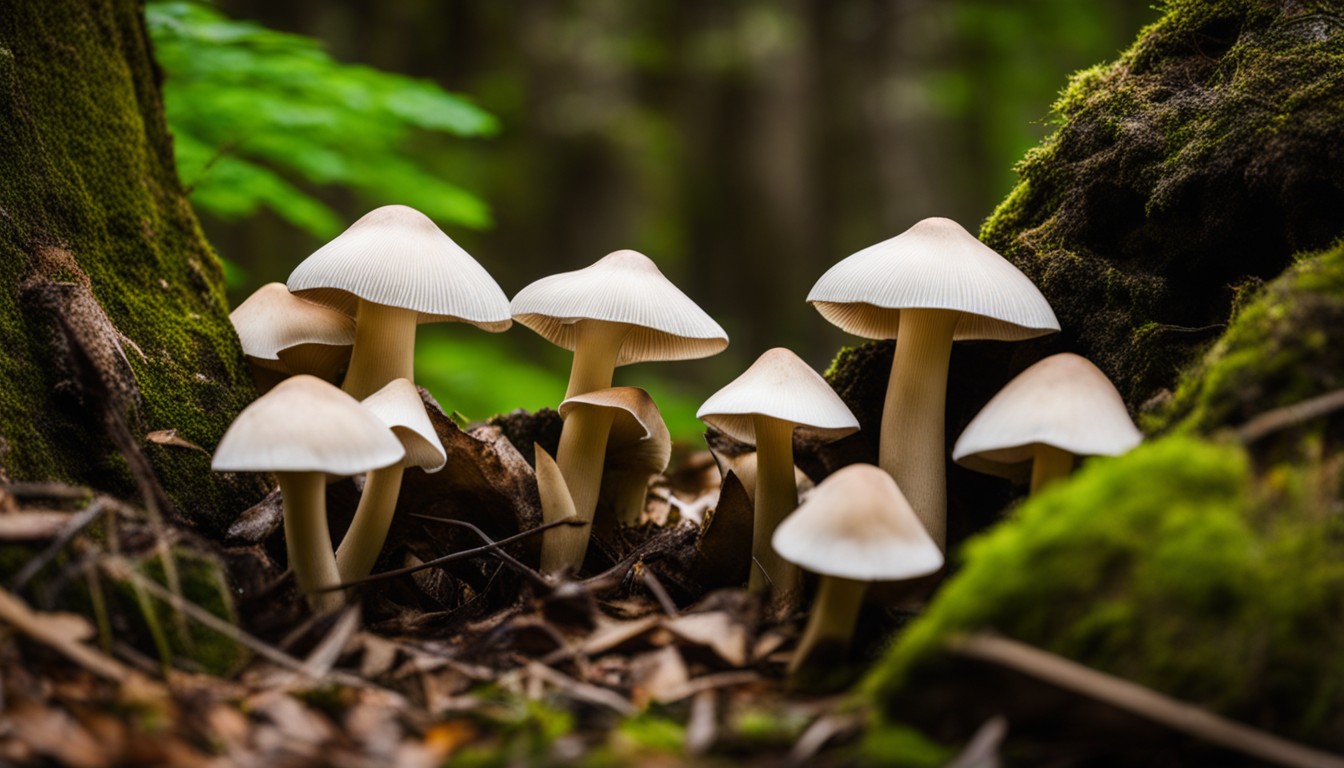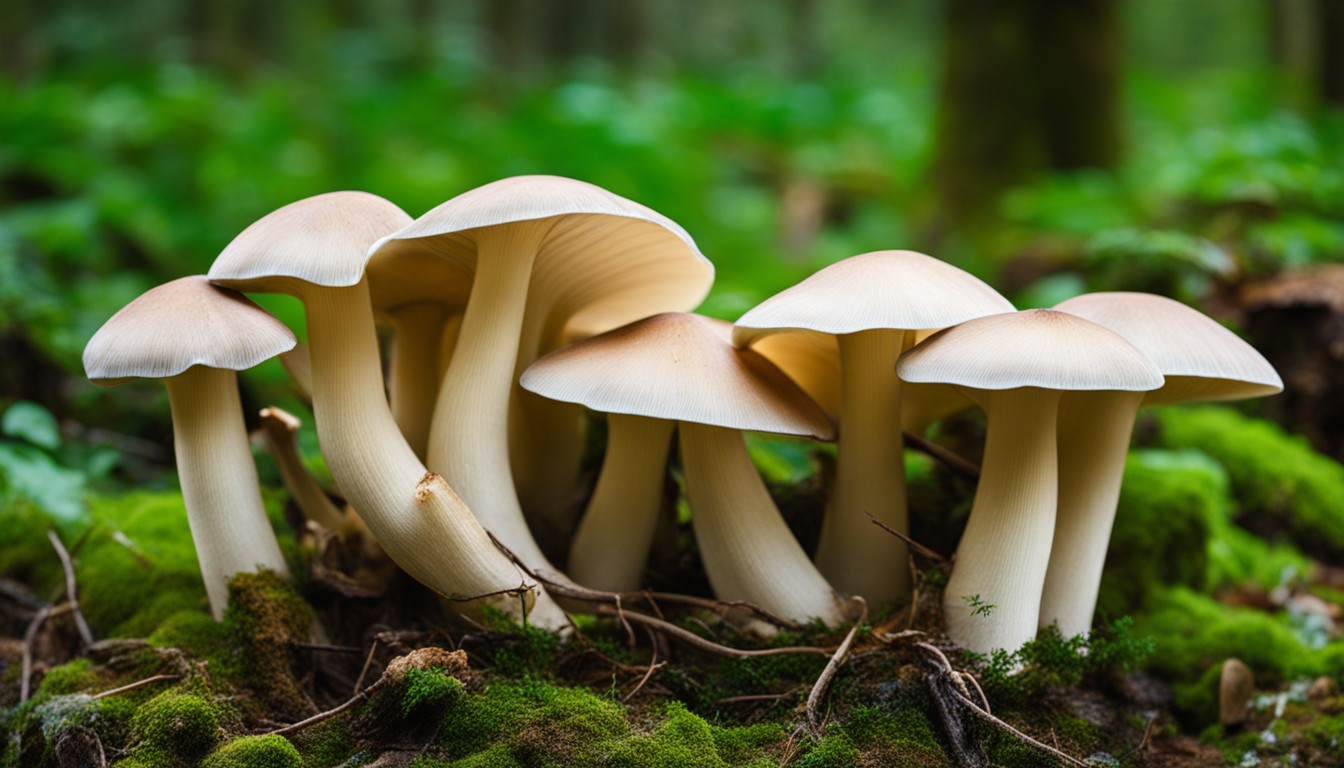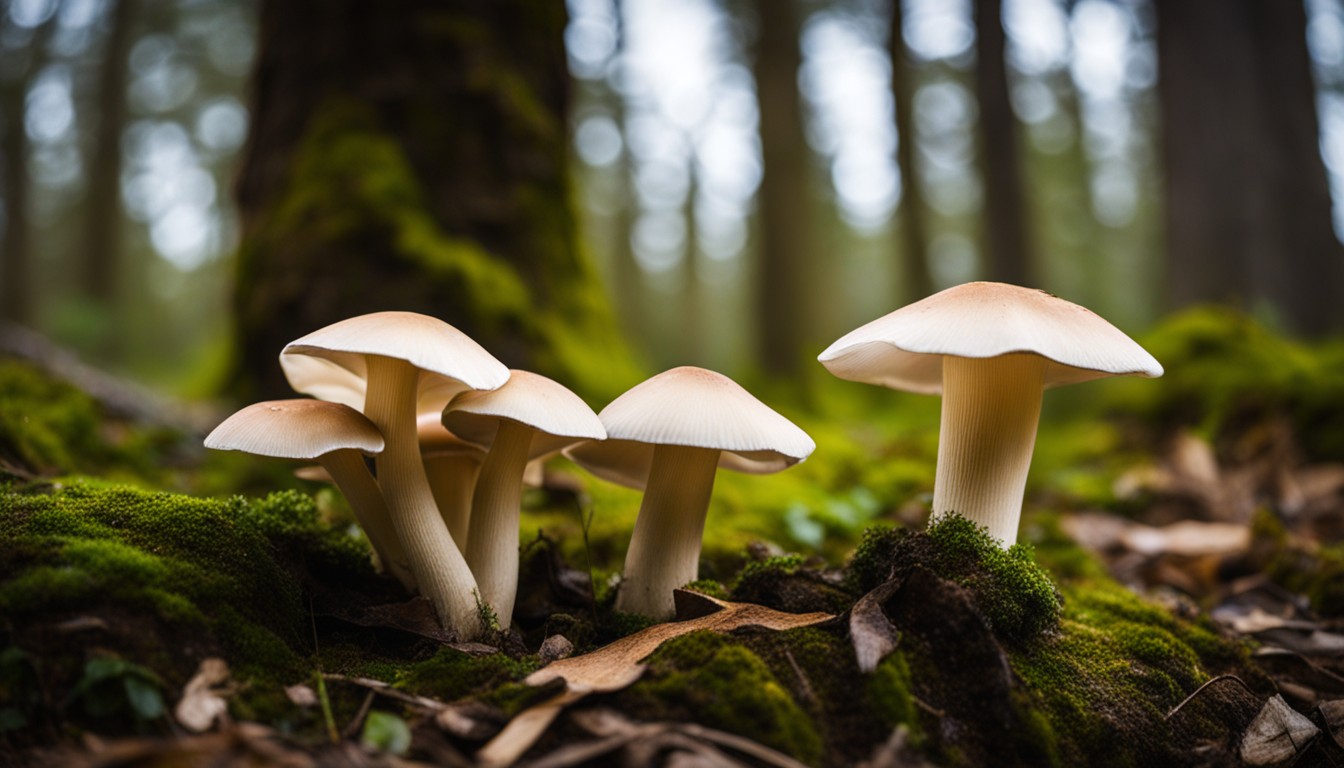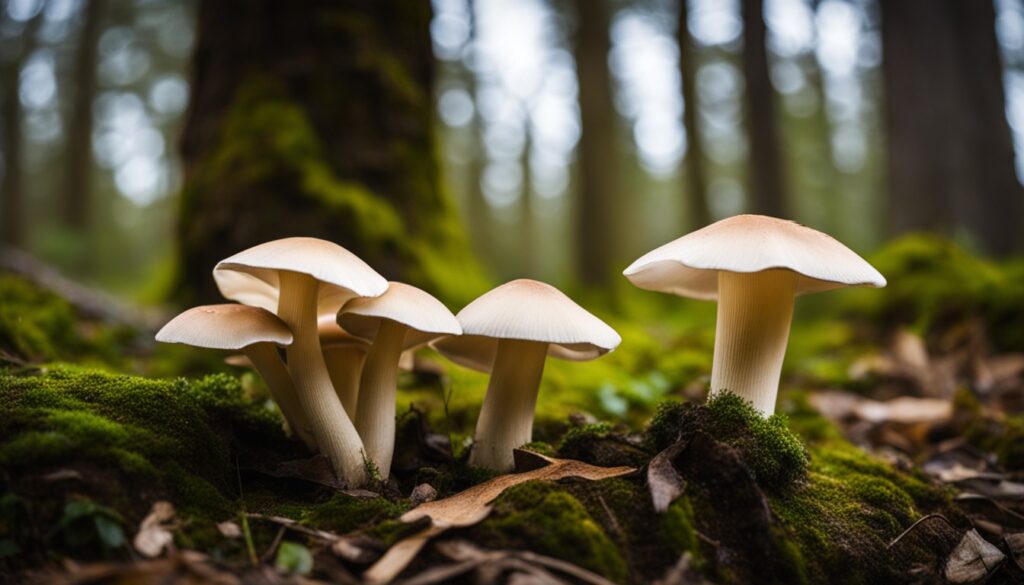New England Mushrooms: A Guide to the Fungi of the Northeast is a comprehensive resource that explores the diverse world of mushrooms found in the New England region. In this blog post, we delve into the various species, their characteristics, and where to find them in the Northeast. Whether you’re a nature enthusiast, a forager, or simply curious about mushrooms, this guide will help you discover the fascinating world of New England mushrooms. From identifying different types to understanding their ecological roles, this post provides valuable insights and information for mushroom enthusiasts of all levels. Don’t miss out on this opportunity to enhance your knowledge and appreciation of the fungi kingdom in the Northeastern United States.
Introduction to New England Mushrooms
Mushrooms, integral components of New England’s ecosystem, contribute significantly to the biodiversity and health of its forests. They decompose organic material, foster symbiotic relationships, and serve as an essential food source in their habitats.
New England mushrooms play a crucial role in the region’s ecology and offer opportunities for gastronomic exploration and skills development in identifying different species.
The mushroom species found in New England are diverse, ranging from toxic to edible and medicinal. Knowledge of these various species can provide both culinary enrichment and improve diagnostic skills in identifying harmful varieties.
What are Mushrooms?
In simple terms, mushrooms are a type of fungus that grows above ground or on its food source. They are the reproductive structures of certain fungi, and below the surface, an intricate network of fungal cells known as mycelium perpetuates the life-cycle of these fascinating organisms.
Mushrooms make significant environmental contributions. They have roles as decomposers, breaking down dead plant material, facilitating nutrient cycling. Some associate with plant roots in symbiotic relationships, aiding in the absorption of essential nutrients. Their multi-faceted environmental roles underscore their immense ecological importance.
Why Study Mushrooms in New England?
The wealth of fungi diversity in New England is remarkable, contributing significantly to the rich tapestry of its flora. A systematic study of mushrooms reveals a fascinating insight into these prolific organisms that pepper the region.
Mushrooms are the visible ambassadors of the hidden fungal world, playing a vital role in the health and biodiversity of New England’s forests. Their presence shapes the region’s distinctive ecological character, contributing to a unique biodiversity unrivaled in its complexity.
Types of Mushrooms Found in New England
New England’s diverse fungal taxonomy is richly represented through both common and rare mushroom species. In this region, there is also a plentiful variety of edible mushrooms along with dangerous yet visually captivating poisonous counterparts.
- Chanterelles: Both common and edible, they are bright yellow to orange, trumpet shaped fungi.
- Black Trumpet: A sought-after edible mushroom, dark and elusive in humid wooded areas.
- Fly Agaric: This iconic mushroom, red with white spots, while beautiful, is toxic and should not be consumed.
- Destroying Angel: This white mushroom is one of New England’s most poisonous and should be avoided.
- Morels: Popular, edible, and distinctive, with their honeycomb-like appearance.
- Hen of the Woods: Common and edible, found at the base of oak trees, with a layered, feather-like structure.
- Cinnabar Red Polypore: Non-toxic, but not particularly appetizing, it adds a bright pop of red color in the forest.
- Bioluminescent Panellus: A rare sight, these mushrooms exhibit a faint green glow at night.
Mushroom Identification Techniques

Understanding mushroom identification goes beyond the casual glance. It requires a broad spectrum of knowledge, deep observation, and experimental techniques like spore print analysis to correctly distinguish one species from another. Strengthen your proficiency with the use of field guides and digital mushroom ID apps for accurate and safe identification.
Safety should be a paramount concern when hunting for edible mushrooms in New England. Don’t solely depend on size, color, shape, or habitat, but consider comprehensive features including smell, season patterns, and molecular DNA testing. Cross-check your findings with experts or mycological societies before any consumption.
Physical Characteristics of Mushrooms
Identifying mushrooms requires a meticulous eye and a thorough knowledge of their diverse and intricate physical features. From the subtle differences in cap texture to the color variations at the stem base, correct identification hinges on these minute differences. It’s virtually impossible to broadly classify mushrooms without detailed observation.
Begin your identification journey with an investigation of the mushroom’s cap. Its color, shape, and texture might hold significant clues about its family and species. Whether it’s convex in shape or has an inky cap, this feature may be the first step to decisive identification.
Next, shift your focus to the stem or stipe. The presence or absence of a ring, also known as an annulus, and the stem’s overall length and thickness can aid in mushroom identification. Take note of any distinct aroma given off by the stem, which can serve as a shrewd identification tool.
Underneath the cap, you find the gills, ridges or pores, serving as the mushroom’s spore-dispersal mechanism. Does your specimen sport gills, or is it host to tiny pores? Referred to as the hymenium, this region holds keys to the mushrooms’ genus and might offer valuable insights about its edibility.
Last but not least, carefully observe the mushroom’s spore color by obtaining a spore print. This technique arms you with profound insights into the mushroom’s species and can be an essential tool in separating edible varieties from their poisonous counterparts. Mushroom identification is, after all, a visually-led investigative journey.
Spore Prints and Their Importance
Lending critical assistance in mushroom identification, spore prints act as mushroom ‘fingerprints’. Each mushroom species secretes spores in unique colors and patterns, facilitating an accurate identification.
Underscoring the principle, ‘Every mushroom is edible; some only once’, accurate identification through spore prints can be pivotal. This process requires one to place the mushroom cap, gills down, on a piece of paper, allowing spores to fall and create a visible print over several hours.
Using Field Guides and Apps for Identification
Accurate identification of mushrooms can often be a daunting task. The advent of technology, however, has eased this challenge with comprehensive field guides and applications designed specifically for mycology enthusiasts.
- ‘Mushrooms of the Northeast: A Simple Guide to Common Mushrooms’ by Teresa Marrone and Walt Sturgeon
- ‘National Audubon Society Field Guide to North American Mushrooms’ by Gary H. Lincoff
- Mushroom Identify – Automatic Picture Recognition App, this AI-driven app can help identify the species of a mushroom
- ‘iNaturalist’ – a mobile application that allows you to record your observations of nature and share them with a global community of naturalists
- ‘Mushrooms app’ – an application dedicated to mushroom identification with high-quality photos and a sophisticated algorithm to narrow down the species
Mushrooms in New England Ecosystems

New England’s varying climates provide an ideal habitat for several mushroom species, leading to a fascinating diversity in fungi distribution. These diverse fungal forms perfectly merge into the region’s deeper ecological web.
Mushrooms, as part of the region’s intricately woven food chain, undertake inherent roles that contribute to ecological balance. They provide essential nutrients for various organisms, ensuring the cycle of life continues in New England’s ecosystems.
Mushroom Role in the Forest
Mushrooms exhibit an essential role in the nutrient cycling within New England’s forests. They degrade organic matter, transfer critical nutrients back to the soil. This recycling process supports the overall health and vitality of the forest ecosystem.
An intriguing aspect of New England’s woodlands is the symbiotic relationship between mushrooms and trees. Mycorrhizal fungi, a type of mushroom, forms interconnected networks with tree roots, aiding in water and nutrient absorption.
This mutually beneficial relationship not only allows trees to thrive but also bolsters the resilience of the forest ecosystem. The vast mycelial network acts as signals, transferring nutrients and warning messages across different tree species helping them combat environmental stresses.
Symbiotic Relationships with Trees and Plants
Mycorrhizal mushrooms, ubiquitous in New England forests, cooperate with trees. They exchange nutrients at intricate points of contact, known as mycorrhizae, identifying mushrooms as crucial contributors to woodland vigor and productivity.
These unusual partnerships play a pivotal role in the forest’s health, boosting tree defenses, nourishing their growth, and increasing environmental stress resistance. They’re indispensable for a thriving ecosystem.
Focusing on mycelium networks, think of them as underground communication highways. They link the root systems of plants, facilitating nutrient transfer across the woodland floor.
In this magnificent interplay, mycelium networks orchestrate plant communities’ survival in New England. Nutrition, growth, reproduction, and resilience all benefit from this marvelous fungal architecture.
Mushrooms as Decomposers
Mushrooms, often referred to as nature’s composters, play an integral role in breaking down organic matter across New England’s diverse landscapes. By decomposing dead plant materials such as leaves, bark, and wood, they convert complex organic matter into simpler components.
This decomposition is critical to improving soil health, adding vital nutrients that enhance its fertility. Besides, by breaking down organic material, they expedite carbon and nitrogen cycling, thereby promoting soil biodiversity and productivity.
In essence, the decomposer fungi, prominently found in New England, are vital stewards of the ecosystem. Without their silent work in the background, nutrient cycling would grind to a halt, significantly impacting soil health and subsequent plant growth.
Edible and Medicinal Mushrooms

Home to a plethora of edible varieties, New England’s forests offer mushrooms like Chanterelles and Morels, renowned for their distinct flavors and health-enhancing properties, including boosting immunity and contributing to heart health. Consumption of these easily identifiable species provides significant nutritional benefits.
New England’s medicinal mushrooms, such as Reishi and Turkey Tail, can be seamlessly incorporated into daily wellness regimes. These fungi are noted for their potential in supporting the immune system, maintaining cardiovascular health, and some even possess potential anticancer properties.
Safe Identification of Edible Mushrooms
Edible mushroom identification requires a meticulous and careful approach. It’s critical to never assume a mushroom’s edibility based solely on its appearance. Always remember that many toxic mushrooms closely resemble their edible counterparts.
New England mushroom foraging demands a meticulous eye for detail. Misidentification can cause severe reactions, or in extreme cases, death. Despite these risks, when conducted correctly, foraging can yield a plethora of healthful and delicious species.
The use of well-curated field guides and identification apps enhances the accuracy of identification. If you’re unsure of a mushroom’s identity, its potency, or have any doubts, refrain from consumption entirely. Safety first should be the foremost rule in foraging adventures.
Foragers can avoid mushroom poisoning by cooking all wild mushroom carefully. Cooking breaks down any potential toxins and makes the mushrooms safer to eat. However, it should be noted that cooking does not neutralize all toxins, hence proper identification remains key.
Additionally, make it a personal rule never to consume unknown mushrooms or combine different types in a single meal. Mushroom toxins have diverse reactions, combining them can result in unpredictable responses or aggravate symptoms.
Popular Culinary Mushrooms in New England
In New England’s culinary scene, certain indigenous mushrooms have made their mark. From quaint home kitchens to high-end restaurants, these fungi are highly sought after.
- New England’s star ingredients include the Morel mushrooms, black trumpet, and hen of the woods
- The Matsutake, also known as pine mushroom, is celebrated for its distinctive aroma and flavor
- Lion’s mane, delicious and known for its cognitive benefits
- Chanterelles, recognized for their bright color and unique flavor
- Cooking techniques range from simple sautéing to using them in complex dishes like mushroom risotto or gourmet pizzas
Medicinal Properties of Mushrooms
New England is home to a variety of mushrooms with intriguing medicinal properties. From anti-inflammatory effects to cancer-fighting compounds, these indigenous fungi are emerging as a natural pharmacy.
One notable example is the Reishi mushroom. Commonly found across the Northeast, this fungus has been linked to improved immune function and reduced stress due to its abundance of ganoderic acids.
Turkey Tail, another New England native, is recognized for its cancer-fighting polysaccharopeptides. Studies suggest that it can also improve gut health and boost the immune system.
The Lion’s Mane mushroom, found in northeastern woodlands, is known for its neuroprotective properties. It has been studied for its potential to improve cognitive function and provide relief from neurological conditions.
However, while exciting, the medicinal potential of mushrooms warrants caution and further research. It’s critical to remember that safe and accurate identification is essential, and consumption should only occur under professional guidance.
Common Mushroom Dangers and Poisonous Species
In the verdant forests of New England, some mushrooms pose a grave threat. Species like the Destroying Angel, Death Cap, and the Galerina marginata, with their lethal doses of toxins, populate this region, making the process of identification crucial for safety.
Toxic fungi such as the False Morel and the Jack O’ Lantern Mushroom, commonly found in New England, beautifully mask their danger. Their resemblance to edible species underscores the need for accurate identification, highlighting the importance of studying their unique features closely.
Dangerous Look-Alikes
Care is critical when identifying mushrooms in New England, as dangerous doppelgängers can closely mimic edible species. Misidentification can lead to consuming toxic varieties, often with severe health consequences.
New England’s rich biodiversity provides ample opportunities for dangerous look-alikes to thrive. Various mushroom species closely resemble each other, making it vital for foragers to familiarize themselves with distinctive characteristics to avoid hazardous encounters.
Toxic Mushrooms Found in New England
While New England’s autumnal landscapes charm with picturesque mushrooms dotting the forest floor, caution should be exercised. Some fungi species, though beguiling, pack a toxic punch that can pose serious health threats.
- Amanita phalloides, also known as ‘Death Cap’, is notorious for its lethal toxins.
- Amanita bisporigera or ‘Destroying Angel’ is a white, innocent-looking mushroom that conceals deadly poisons.
- Galerina marginata, commonly known as the ‘Deadly Galerina’, is a small brown mushroom with equally deadly effects.
- Clitocybe dealbata, the ‘Sweating Mushroom’, is a small, white mushroom commonly found in grassy areas and carries toxins that induce nausea.
Frequently Asked Questions (FAQ) about New England Mushrooms
Learn more about the fascinating world of New England mushrooms, their ecological roles, identification techniques, and potential culinary or medicinal uses.
What are the ecological roles of mushrooms in New England?
Mushrooms in New England play crucial roles in forest ecosystems, including nutrient cycling, decomposition, and symbiotic relationships with plants.
How can I identify mushrooms found in New England?
To identify mushrooms in New England, it’s important to closely observe their physical characteristics, such as color, shape, size, and the presence of gills or pores. Consulting field guides or joining local mushroom clubs can also help enhance your identification skills.
Are there any edible mushrooms unique to New England?
Yes, New England is home to a variety of edible mushrooms, including the famous chanterelles, morel mushrooms, and lobster mushrooms. However, it is vital to exercise caution and seek expert advice before consuming any wild mushrooms.
Can New England mushrooms be used for medicinal purposes?
Some New England mushrooms have been used for their medicinal properties for centuries. Examples include lion’s mane mushrooms, known for their potential cognitive benefits, and turkey tail mushrooms, which have immune-boosting properties. However, it is important to consult with a healthcare professional before using mushrooms for medicinal purposes.
Are there any poisonous mushrooms in New England?
Yes, New England has several poisonous mushrooms, such as the death cap and destroying angel. It is crucial to avoid consuming any wild mushrooms unless you are an expert mycologist or have received proper training in identification.
Remember, always exercise caution and prioritize safety when foraging for mushrooms or using them for any purpose.
Conclusion
Final Takeaway: New England’s mushrooms are marvels of the natural world, offering a stunning variety in form, function, and influence on the ecosystem. They play vital roles in forest health, provide culinary delights, and pose significant dangers to the unwary.
- The Fungi Facts: There’s a mind-boggling diversity of mushrooms in New England, both edible and poisonous.
- Mushrooms play critical roles in forest ecosystems, acting as decomposers, symbiotic partners, and sometimes pathogens.
- Knowing the correct identification techniques is vital, not only for foragers seeking edible species, but to avoid potential health risks associated with toxic mushrooms.
- Certain mushrooms found in New England, like the Morel or the Shiitake, are esteemed for their culinary value.
- Mushrooms such as Reishi and Chaga are valued for their medicinal properties, recognized for their potential health benefits for centuries.

